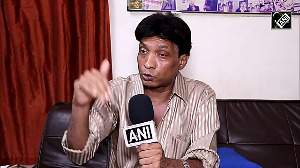What makes Daulat ki Chaat so freaking good? Geetanjali Krishna finds out!

Last week, I went to Old Delhi with a bunch of foodie friends and one of the first stops we made was at a roadside stand of Daulat ki Chaat.
"Have some Daulat ki Chaat," the vendor coaxed us.
"It's a delicacy fit for kings but sold only on the roadside!"
We needed little persuasion -- this light, frothy (and inappropriately named) dessert is a Chandni Chowk standard and quite the miracle of kitchen chemistry.
We ordered a couple of donas -- leaf bowls -- and marvelled at its souffle-like airiness.
The vendor, Ajab Singh, said he made it himself in the morning. Of course, we all wanted to know how.
The process, he said, was long and challenging.
"Every evening, I place a mixture of milk and cream on ice overnight. Then, before dawn, I begin whisking the mixture with a wooden churner. After a while, the froth on the milk begins to thicken and I gently peel it away from the liquid milk in a strainer and stack it on this platter," said he.
It takes him over three hours to churn a day's worth of Daulat ki Chaat.
"Some people have started using electric whisks, but the result isn't as light as it is by hand!" he said.
The resulting product is so delicate, he said, that sugar and a little fried khoya, milk solid, can be added only seconds before eating. "Otherwise, it will just lose the air and fall flat!" he said.
The Daulat ki Chaat literally disappeared in the mouth, leaving behind a mild, milky sweetness.
As I stood on the crowded road eating it, I reflected that it has to be the quintessential anti-establishment dessert.
You won't find it in a sweet shop or restaurant, for it is made by hand and sold only on khomchas, tripods.
As it can only be made from ice-cold milk and can only keep in low temperatures, it is available only from December to February.
It is highly perishable, not lasting for more than a couple of hours once made. So it can't be made in large quantities, neither can it be stored.
Vendors such as Singh make only what they can sell in a day and stand only in shady nooks across the Walled City.
"Luckily, the demand for it is such that I usually sell all that I make by afternoon," he said.
One could buy single servings for Rs 30 each, or the entire platter for anywhere between Rs 2,000 to 3,000.
"Often, I get orders for parties, and churn milk through the night to fulfil them!" he said.
Later that afternoon, returning to the metro station at the end of our quest for Old Delhi's cuisine, I saw him again.
He smiled when I said we'd had another round of the dessert at another khomcha ahead.
"One of my relatives owns that khomcha," he said.
"In fact, most of the Daulat ki Chaat sellers here are from my village in Moradabad district! We come every year for this season, rent rooms in Sitaram Bazar and ply our trade."
The rest of the year, said he, like him, they also returned to their village and tended their fields.
"Every season, I earn between Rs 30,000 to 40,000 to take back home," he said.
I was curious to know how something so symbolic of Delhi came to be made by migrants.
"I don't know, maybe one of my ancestors perfected the recipe and trained generations of people from my village..." he said.
"Dilli-walas just can't make this well. My uncle taught me how to make Daulat ki Chaat -- now I'm training my nephew. I guess I'm doing my bit to ensure that as long as there are people who appreciate Delhi's unique delicacy, there will be people from my family in Moradabad who are making it."
Photo: Rohan Prakash/Creative Commons












 © 2024 Rediff.com -
© 2024 Rediff.com -